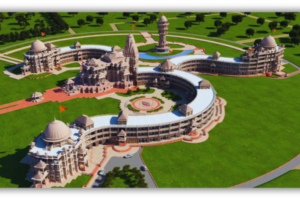Haunted Bhangarh Fort Rajasthan, is situated amidst the Aravalli Range in Alwar district, Rajasthan. Its strategic location atop a hill provides panoramic views of the surrounding landscape. The architecture of these structures includes elements like balconies, jharokhas (overhanging enclosed balconies), courtyards, and intricate lattice work on windows. The architectural style of Haunted Bhangarh Fort Rajasthan, is a blend of Rajput and Mughal influences, reflecting the historical interactions and cultural exchange between these dynasties. The use of intricate carvings, geometric patterns, arched gateways, and domes exemplifies the fusion of Rajasthani and Mughal architectural elements. Overall, Bhangarh Fort’s architecture stands as a testament to the rich heritage and craftsmanship of the bygone era, offering visitors a glimpse into the architectural marvels of medieval Rajasthan.
The fort is constructed using local sandstone and is surrounded by fortified walls that enclose an extensive area, including several temples, palaces, and gateways.

The Fact Story About haunted Bhangarh fort Rajasthan:-
1. The Beautiful Princess Ratnavati: Bhangarh Fort was built in the 17th century in Rajasthan, India, by Raja Madho Singh, the younger brother of Man Singh, a general in the army of Mughal Emperor Akbar. Within the fort’s walls lived a beautiful princess named Ratnavati, who was known for her mesmerizing beauty and charm.
2. The Enchanting Wizard Singhiya: In the nearby village lived a wizard named Singhiya, who was well-versed in black magic and sorcery. Singhiya was drawn to Princess Ratnavati’s beauty and decided he must have her as his own. However, the princess was already destined to marry someone else.
3. The Unrequited Love: Singhiya, consumed by his desire for Ratnavati, devised a plan to win her affection. He used his dark powers to create a magical potion or perfume that would make the princess fall in love with him instantly upon smelling it.
4. The Princess’s Wisdom: Ratnavati, however, was no ordinary princess. She was wise and intuitive, and she sensed the dark intentions behind Singhiya’s actions. When the wizard presented her with the potion disguised as a gift, she saw through his deceit.
5. The Curse: Enraged and humiliated by the princess’s rejection, Singhiya unleashed a powerful curse upon the fort and its inhabitants. He cursed that no one would ever be able to live within the fort walls and that anyone who tried would meet a tragic end. Legend has it that he also cursed Ratnavati to die a violent death.
6. The Fort’s Abandonment: The curse took hold, and the once-thriving Bhangarh Fort fell into ruin. Its residents either perished or fled, leaving the fort abandoned and haunted by malevolent spirits.
Haunted Bhangarh Fort Rajasthan Entrance Gates:-
The fort has several entrance gates, each with its own architectural significance. The main gate, known as the “Bhangarh Gate,” is a grand structure with ornate carvings and intricate designs, showcasing the craftsmanship of the era.
Temples:-
Within the fort complex are several temples dedicated to Hindu deities such as Lord Shiva, Gopinath Temple, Hanuman Temple, and Someshwar Temple.
These temples feature traditional Rajput architecture characterized by intricately carved pillars, domes, spires, and decorative motifs depicting mythological scenes and religious symbols.
Water Management:-
The fort also features a complex system of water reservoirs, step wells (baoris), and channels that were designed to collect and distribute water for the fort’s inhabitants and agricultural needs. The water management system showcases the engineering prowess of the builders and their understanding of sustainable infrastructure.
Best Time to Visit & Fee:-
Winters (October – February)
Free Entry





